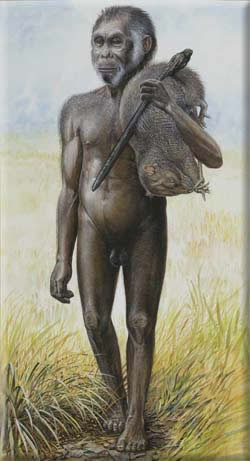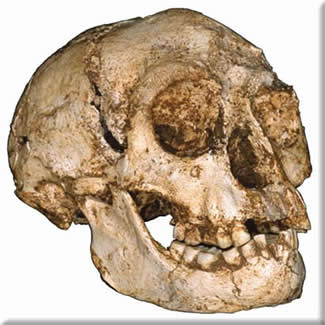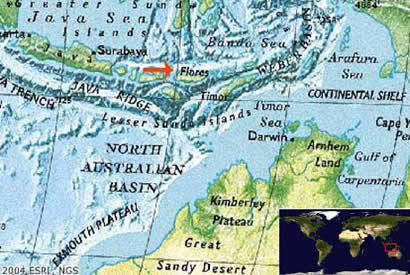03.06.05
 The scientists who discovered the skeleton proving that a species of human dwarfs lived in Indonesia 18,000 years ago are to return to investigate claims that the species survived until modern times.
The scientists who discovered the skeleton proving that a species of human dwarfs lived in Indonesia 18,000 years ago are to return to investigate claims that the species survived until modern times.
Researchers, who found a female skeleton of a new kind of early hominid on the Indonesian island of Flores named it Homo floresiensis - and nicknamed it "the hobbit".
They have gathered local tales that suggest villagers lived alongside the 3'-tall hominid until just two centuries ago, when the humans killed off their neighbours.
The discovery of the skeleton surprised scientists and seems to give credibility to folk stories about little people which informed JRR Tolkien's creation of The Hobbit.
Remains the research team have found in Indonesia so far date from between 13,000 and 18,000 years ago.
Dr Chris Turney, the only Scottish member of the research team, explained: "One of my colleagues, Gert van den Bergh, came across folk memories of a different species of human on Flores: stories of the 'ebu gogo', meaning the ancestral grandmother who eats anything.
"They were hairy, with arms down to their knees, they could not talk but could repeat sounds. They would come to the edge of the village, where villagers would leave them food. They would even eat the plates."
He said the creatures locals described as the research team began its work on Flores eight years ago bore a distinct resemblance to the six hobbit skeletons discovered in a cave called Lian Bua in October 2003.
Last week, a study by Dean Falk, professor of anthropology at Florida State University, published in Science journal, proved that the hobbit skull was definitely from a new species rather than that of an abnormal human, chimpanzee or another earlier hominid, Homo erectus.
Turney said that one of the team's next projects would be to investigate the island folklore, to see if there was any more scientific proof of the hobbits and how and when they became extinct.
He added that the islanders could not have made up their stories because they were giving detailed accounts before the discovery was made.
"They said Homo floresiensis were around until 200 years ago, when they stole a baby from the village. The villagers said their ancestors tossed hay and torches into a volcanic cave where the hominids lived and burned them all.
"We will go back and look for this cave by a village near the town of Bajawa."

Turney, who was born in Inverness and now works as the carbon-dating expert for the team and as a fellow at the University of Wollongong in Australia, said the discovery had important implication for other islands.
As well as providing a new example of competing species of humans living at the same time - in this case, the modern human, Homo sapiens, and Homo floresiensis - he said that the discovery shows that early humans were subject to a peculiar island phenomenon: shrinking.
"People moved out of Africa earlier than was previously thought, and must have built craft to get out to the island [two million years ago]," he said. "But the discovery also shows that humans are as vulnerable to dwarfing as other mammals, which shrink on islands like the deer on Jersey."
Turney now believes the islands close to Flores may be home to other kinds of hominids. "There is a good chance that some of the species remained on islands on the way or nearby, such as Lombok and Sulawesi. With totally different plant and animal life, maybe all of these islands have a human from two million years ago, that formed into a different species."

The hominids found by the scientists in that one cave appear to have died as the result of a volcanic eruption, and Turney is currently analysing a thick layer of ash above which no more remains were found. Excavations will start at the neighbouring island of Sulawesi in July.
Although the first discovery of the hominid was announced to the world last October, the find was made a year earlier and since then Turney and the rest of the research team have been building a picture of the community's life. The uncovering of stone tools and the remains of large prey, for instance, show that Homo floresiensis was an accomplished hunter.
Professor Bert Roberts, a geologist on the research team, said that Homo floresiensis should be viewed as just one of a number of previous human species.
"We have a very distorted view of human history. It has not been one human species, ourselves, living on this planet for the last two million years. It's been a whole host of human species. As recently as 30,000 years ago, at least three human species [modern humans, Homo floresiensis and Neanderthals] inhabited the planet."
Later this month, the work of the team is featured in a documentary film about human evolution, Ultimate Survivor: The Mystery Of Us, on the National Geographic Channel.

